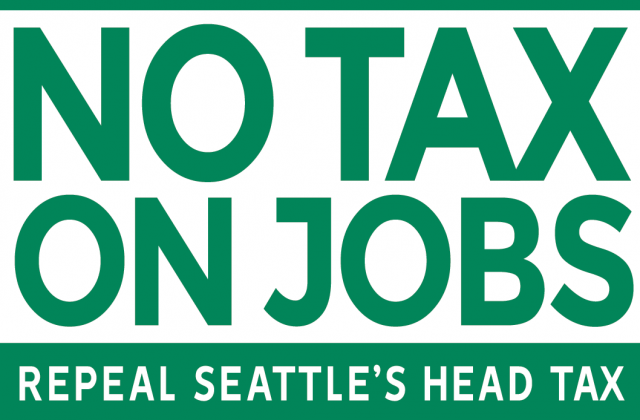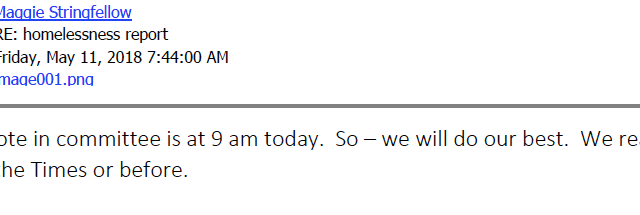Tax On Jobs Repeal Effort Exists!
Efforts are now underway to gather signatures to put the tax on jobs passed by the City Council and signed into law by Mayor Jenny Durkan. If you would like to see the tax repealed, the first stop in that process is for enough signatures to be gathered to get the issue on the ballot. The effort underway intends to gather about 25,000 signatures to be sure that they validate and get an item on the ballot for the November election. It is a sprint to get that many signatures to meet the mid June deadline. Remember, the Council said we need $400 million a year to “solve” homelessness, that’s why we need $75 million a year in a tax on jobs, but we’ll accept about $50 million a year. The Mayor agreed. Anyone with common sense and a calculator can tell you that this proposal is bogus; even if you think Amazon created homelessness this proposal does about zero to “solve” the problem, even if you believe the $400 million number.
Reform on the Road: Great Visit to Granger
Last week I had the pleasure of touring several Farmworker housing projects in Granger. The tour was lead by Marty Miller and Cristina Ruiz of the Office of Rural and Farmworker Housing and included the Mayor of Granger, State Senator Judy Warnick, and people from the Washington Policy Center, Center for Latino Farmers, the Grant County Hospital District, Washington State Tree Fruit Association, and the Homeless Network of Yakima County. We co-hosted the tour and lunch with the Center for Latino Leadership. a statewide group working on improving public engagement within the Latino community. The visit was intended to get an up close view of housing issues impacting rural Washington and some housing solutions that work.
We visited a range of projects run by non-profits and by the Yakima County Housing Authority. Housing is scarce in Yakima County. As I’ve pointed out, Seattle has a 3 percent vacancy rate while Yakima County has a 1 percent vacancy rate. The waiting lists for housing are long, and most people are waiting in smaller units doubling or tripling up and making long commutes. But there are some innovative solutions. For example, the Yakima County Housing Authority is piloting a program to use seasonal housing in the off season for housing for homeless people. The pilot program started in late 2016, takes advantage of vacancies in the Cosecha project in Granger.
Yakima Neighborhood Health Services’ Sunnyside office and the Northwest Community Action Center in Toppenish are partnering with the Housing Authority to connect families with the new housing opportunity. Neighborhood Health will fill six units, and NCAC will fill the other four, all with Lower Valley families.
The two agencies will pay $15 a day to rent each unit, or $450 for 30 days, the same price farm workers pay for the units during the summer. Total, that means Neighborhood Health will be paying $2,700 a month for its units and NCAC will pay $1,800.
Eight of the units have eight beds apiece, and two have six beds. The cluster of houses also has laundry facilities, and Krueger says he already has an on-site manager in place to work with families, do weekly inspections and keep everything running smoothly.
Setting up this win-win solution required agencies at the state and federal level to waive limits and requirements to allow the local solution. That’s what some might call “deregulation” and it highlights the point that sometimes well intended rules can constrain local innovation to address problems. Everyone I talked with agreed that more housing is needed in rural parts of our state; but the funds aren’t reaching those who have the greatest needs. Waiving rules is a start, but more funds for building housing are important and can be spent much more efficiently. The Mother Joseph Villa project in Granger cost $10 million for 50 units, or about $200,000 per unit, far less than higher cost units in Seattle. The Mother Joseph project might have even been less expensive and built more units if there were less transaction costs for the tax credits, loans, and Housing Trust Fund dollars.
I asked whether water was an issue. It is. Getting water access adds lots of costs. That’s why I wrote an opinion piece in the Yakima Valley Herald calling for a solution to the problems created by the Hirst decision, a ruling against local property owners and builders to access water by building new wells. A solution was found that dealt with most of that problem, but allowing Housing Trust Fund dollars to pay for water infrastructure, not just units, might make those units more affordable, especially if a Farmworker Housing Authority could borrow against those funds using bonding authority.
The take away from the trip for me was we still have a lot more to learn. But I think it is true that more flexibility to allow local solutions, fewer strings and rules for using state resources, and more investment in infrastructure would help address housing scarcity and high prices in rural communities. I’m looking forward to my next trip.
Reportgate: I Regret Any Confusion, But I Stand by The Facts
Reportgate. It’s a thing. If you don’t know what I’m talking about, good. If you do I am truly sorry. As in many things in life, if I had it to do all over again I would have written my original post about the missing report by McKinsey and Company that some Councilmembers said meant we needed to spend $400 million a year to “solve” housing differently, with the full knowledge of the big uproar it would create. I don’t mind the uproar. I’m used to that and consider that essential to my role. But what has happened in the days since the publication of my post is a lot of negativity. Some people have suggested I am a liar and that I have introduced a false narrative. Others have gone as far as saying I don’t want to help people, that I don’t have compassion, and even that I should disappear.
Well, that’s not going to happen.
I think it’s possible to regret how things turned out while standing by the original premise. That premise is that the public and the press was not given all the information to support the claim that a report by McKinsey indicated that Seattle should spend $400 million to “solve” homelessness. I based my conclusion that a report cited to support this conclusion was neither a report nor available to anyone but a select group of Councilmembers. I extensively sourced my original post. Some are now waving the PowerPoint offered by Councilmember Gonzalez as proof that I am a liar. But I referenced that document in my original post. It is linked and accounted for. I even contacted McKinsey and asked them, “is this PowerPoint the report?” I had already, in my drafting of my post, concluded that there was a strong distinction between the PowerPoint and a forthcoming report. McKinsey agreed with me.
This won’t change a lot of minds about me or what I wrote.
But a very wise person told me that I should express my regret about this not because I was lying but because perhaps I could have been more clear. I tried. I knew that such a claim would generate a lot of controversy. I am not sorry for that. But I wish the controversy was about a process that introduced a big number, $400 million a year, into a debate at the last minute without any way for the public or press to really dig into that number. That’s controversial enough. Councilmember Gonzalez and her colleagues were secretly briefed, McKinsey put numbers out without any methodology behind them, and the press blasted that number out all over the world. That’s just wrong.
But now we’re arguing about whether a PowerPoint can be a report.
The word author has deep meaning. As a Christian, I note that the liturgy sometimes refers to Christ as the “author of our salvation.” The notion of authorship indicates a responsibility, good or bad, for what happens and how and who uses what is written and created. As Jacque Derrida in this clip says, what writers do is serious. I strongly associate myself with his comments. What ever the consequences, writers or creators do what needs to be done. But I do regret that the conversation has degraded the way it has, and as the author, I have to be accountable for that even if I stand by the facts. So I am sorry.
Long Days Journey Into the McKinsey “Report”
I have a more exhaustive post about the push back from supporters of the tax on jobs and why I stand by my original post that there was no report when a report was being cited by Councilmember Gonzalez and the press. I understand the efforts by people and institutions to defend themselves. But as I have pointed out, the Power Point being bandied about as exculpatory is not; I already was aware of that and mentioned it in my original post. Supporters of the tax are trying to undermine what I have written and sourced extensively by pointing to the Power Point. That doesn’t add up. Here’s a time line and the rough set of facts that show why it doesn’t.
Early May — Members of McKinsey’s Seattle office are briefing supportive Councilmembers with a Power Point called “Some Facts” about homelessness.
May 8/9 — David Kroman at Crosscut first refers to the report and the $400 million figure needed to “solve” homelessness. He links to a McKinsey blog post which has not link to a report.
May 9 — The Seattle Times also refers to this same McKinsey post, the $400 million figure, and says it was in a “report.”
May 11 — Councilmember Lorena Gonzalez refers to $400 million figure and the report before voting for the tax in Committee. By this time people in the debate, including Councilmembers and their staff people are looking for this “report” and are unable to find it even until just before the Committee is to vote on the legislation.
May 14 — Still no report has surfaced and the Council votes a compromise out of Committee with other Councilmembers citing the report. By now, many outlets are linking to the Times or Crosscut story talking about the costs of solving homelessness as being $400 million.
May 16 — An editor at the Puget Sound Business Journal says to my colleague, “We’ve been trying to get our hands on it, too. Asked some Chamber folks we know. Nobody has it. Interesting theory about its existence. We’ll definitely keep digging. Let me know if you find anything.”
Later on that day, we get an attachment to the Power Point.
May 17 — McKinsey’s communication person writes: “As mentioned, we’re working on a longer version of the McKinsey Quarterly article on this (https://www.mckinsey.com/featured-insights/meeting-societys-expectations/booming-cities-unintended-consequences). It should be ready in a few days and will make sure to send you a copy asap.”
Later, another McKinsey staffer sends an email saying, “Thanks for getting in touch regarding our research. Here is a link to our latest McKinsey Quarterly article “Rising incomes, rising rents, and greater homelessness. A longer version article will be published in the next few days. We will make sure to share it with you when it comes out.”
May 18 — My colleague receives this email with a link which is at the bottom of my Forbes story: “Following up on my email from yesterday, please find attached our latest longer form article, titled: The economics of homelessness in Seattle and King County.”
May 23 — My Forbes story posts. People go nuts.
And here is just a litany of facts:
- The post I wrote had many difference sources, some on record and some off. Some of the sources were in the City and at a very high level.
- The information requests I made were mirrored by a colleague. Several of the requests for information were made not just by me but by someone else entirely to double check the response.
- When Councilmember Gonzalez cited the figure of $400 million many people wanted to see the report.
- The only document that could be found was the blog post that I criticized as confusing correlation with causation.
- On May 8th, the Seattle Times reported that “But Seattle Councilmember M. Lorena González, after reading details of the report in The Seattle Times, pushed back against the chamber’s assertion that the current spending on homelessness is enough, when this analysis proves that it isn’t, she said.” I thought she had the report.
- When asked for the actual report, nobody could produce it.
- Sources told me there was a Power Point used to brief staff, but not a report.
- A source provided that Power Point.
- Other Councilmember staff (see featured image from a public disclosure) asked Councilmember Gonzalez and McKinsey for the report, they couldn’t get it either.
- When asked directly, McKinsey communication staff said they were working on a report and they’d get me a copy when they were done, “asap.”
- Another request to McKinsey for the report resulted in an actual report, or longer article, about 10 days after the first press report, and about a week after the Committee meeting in which Councilmember Gonzalez cited it.
- No other media outlet has actually linked to that report except me at Forbes at the bottom of my original article.
- When confronted by the Report That Never Was story, Gonzalez responded that she had the report all along;
- And then she sent the Power Point to media as evidence that she was citing a report. This is the Power Point I earlier received and cited in my original post.
$400 Million a Year to Solve Homelesses? Fake News!
The next time you hear someone saying Seattle needs $400 million a year to “solve” homelessness, send them my post at Forbes, Seattle: A Tax On Jobs, $400 Million, And The Report That Never Was.
City leaders were citing a report that never existed, reported as fact by reporters that never verified its existence, to justify a tax on jobs. Based on conversations with more than half a dozen sources, what became clear was that McKinsey lobbied City staff ahead of the vote using a Power Point.







